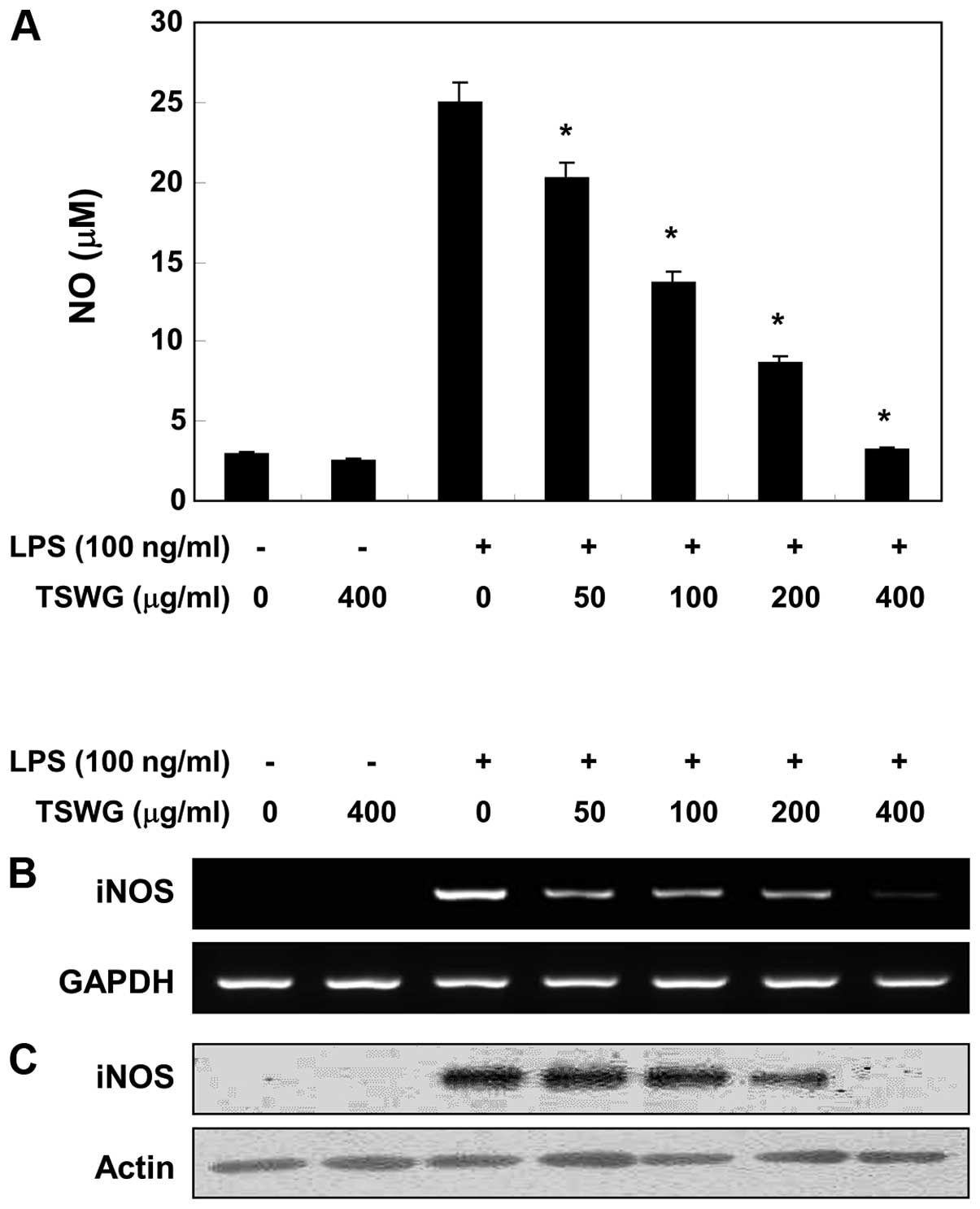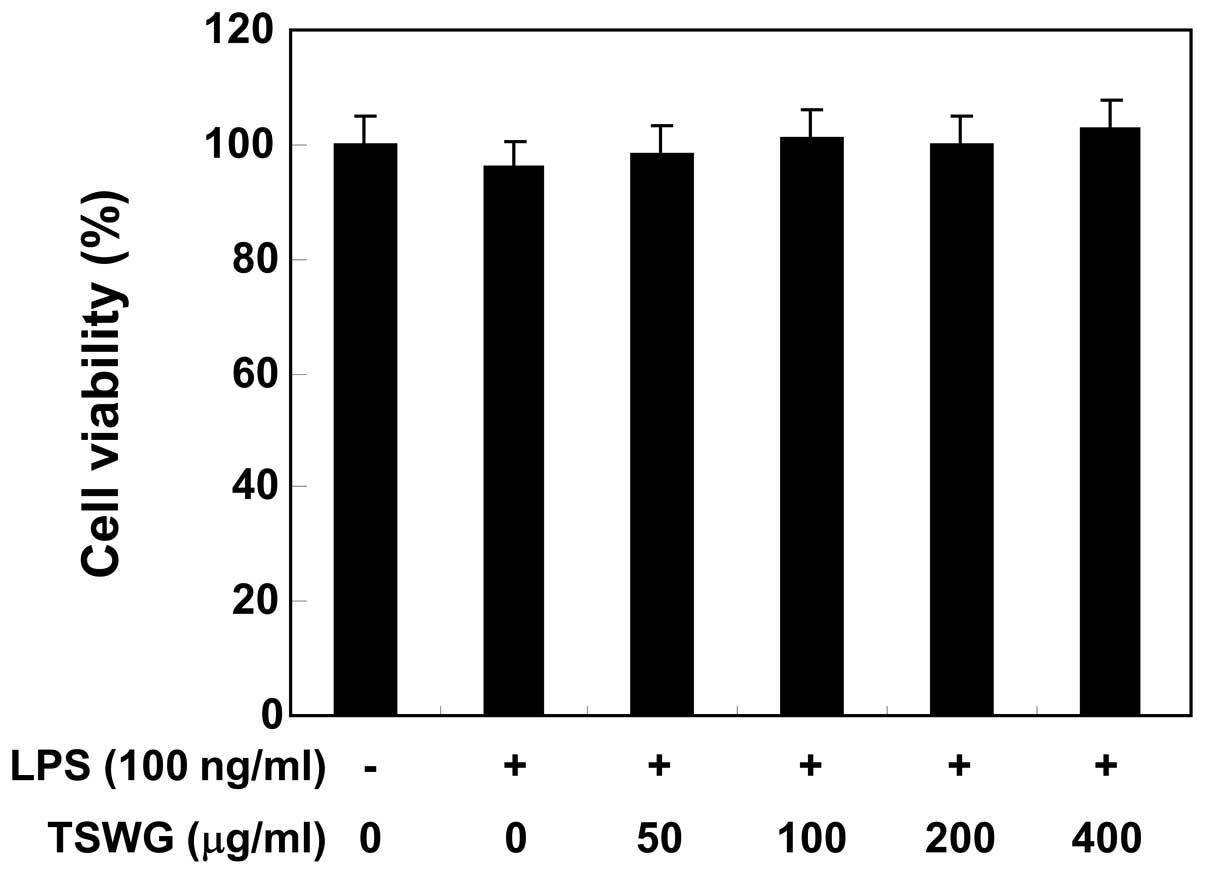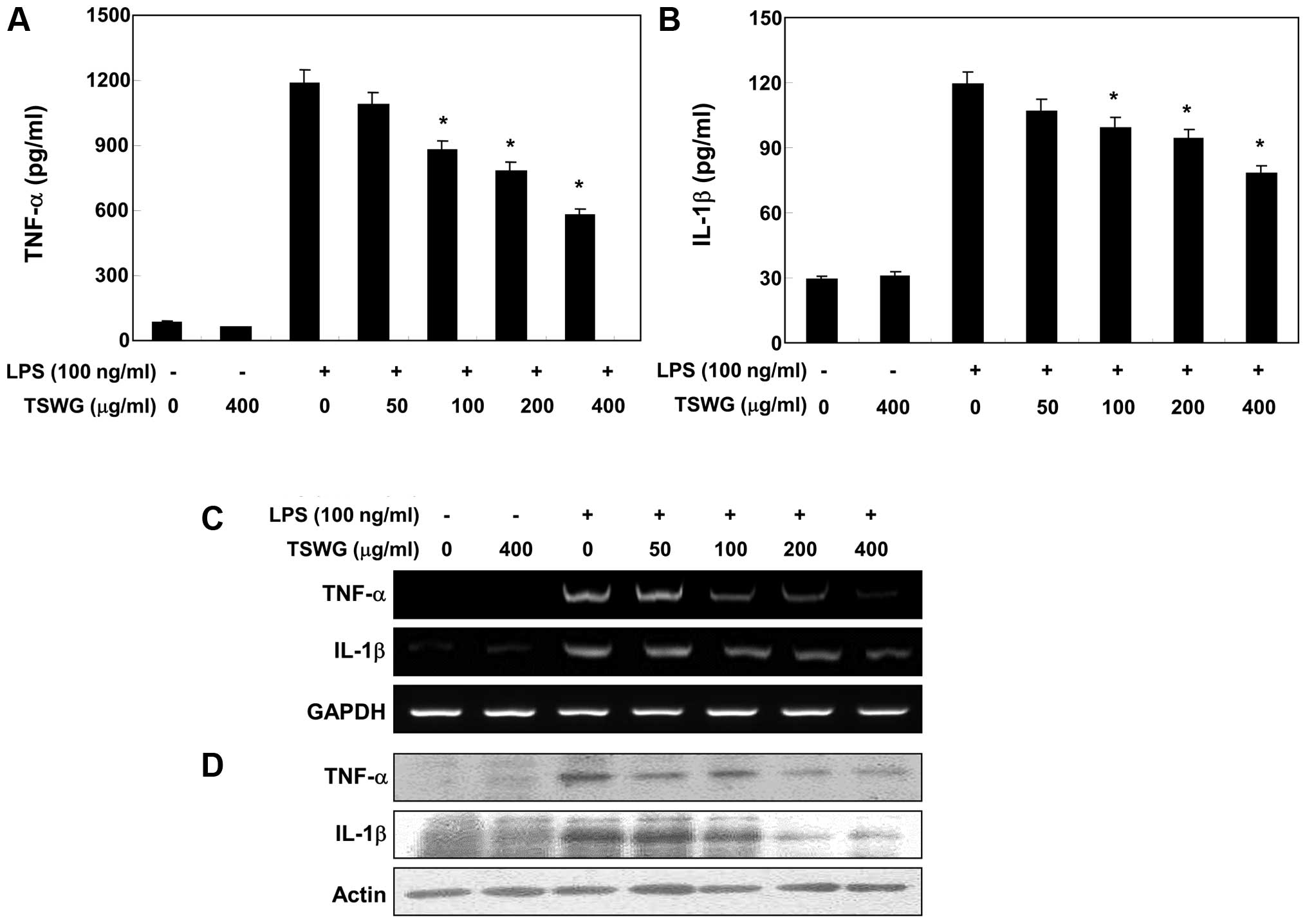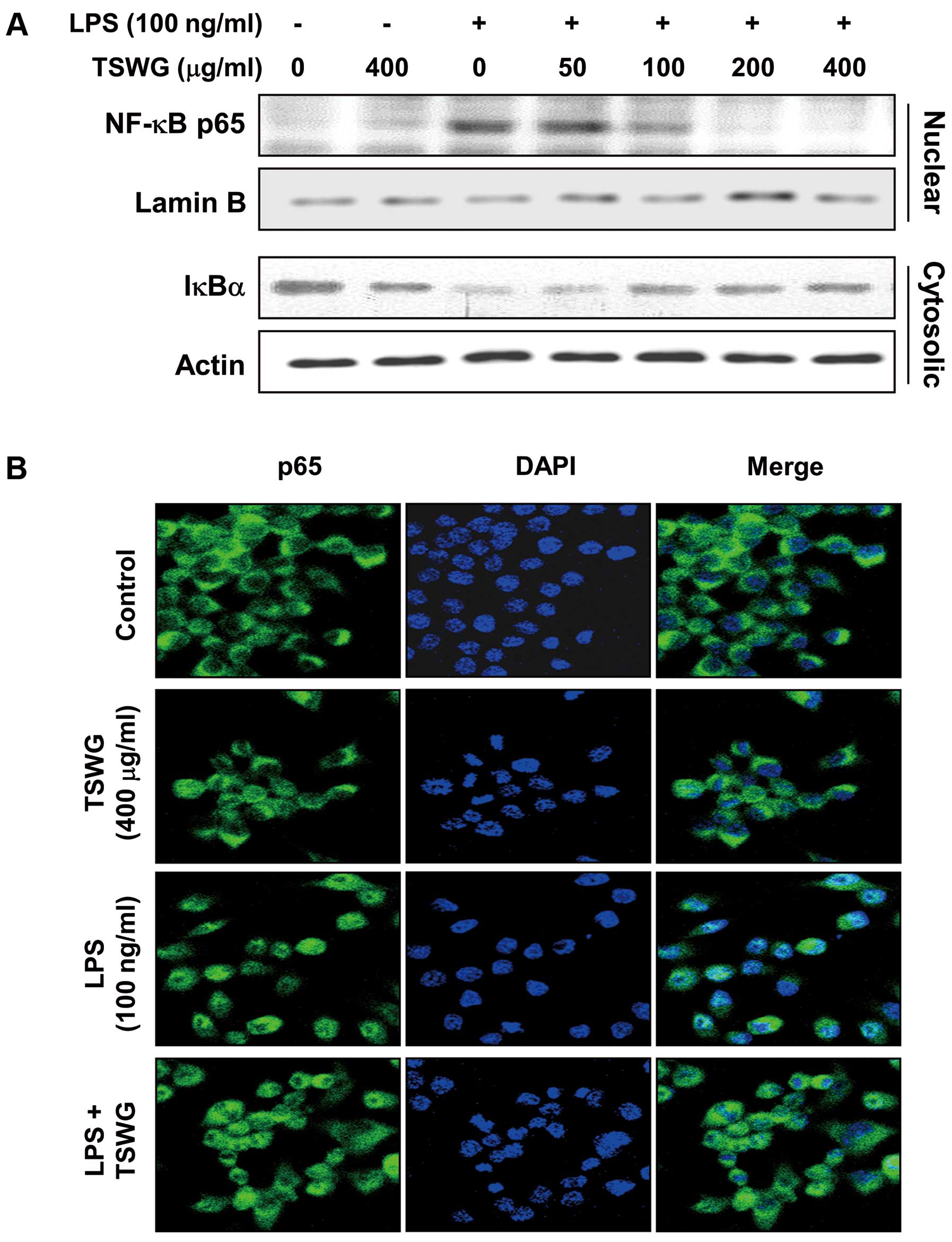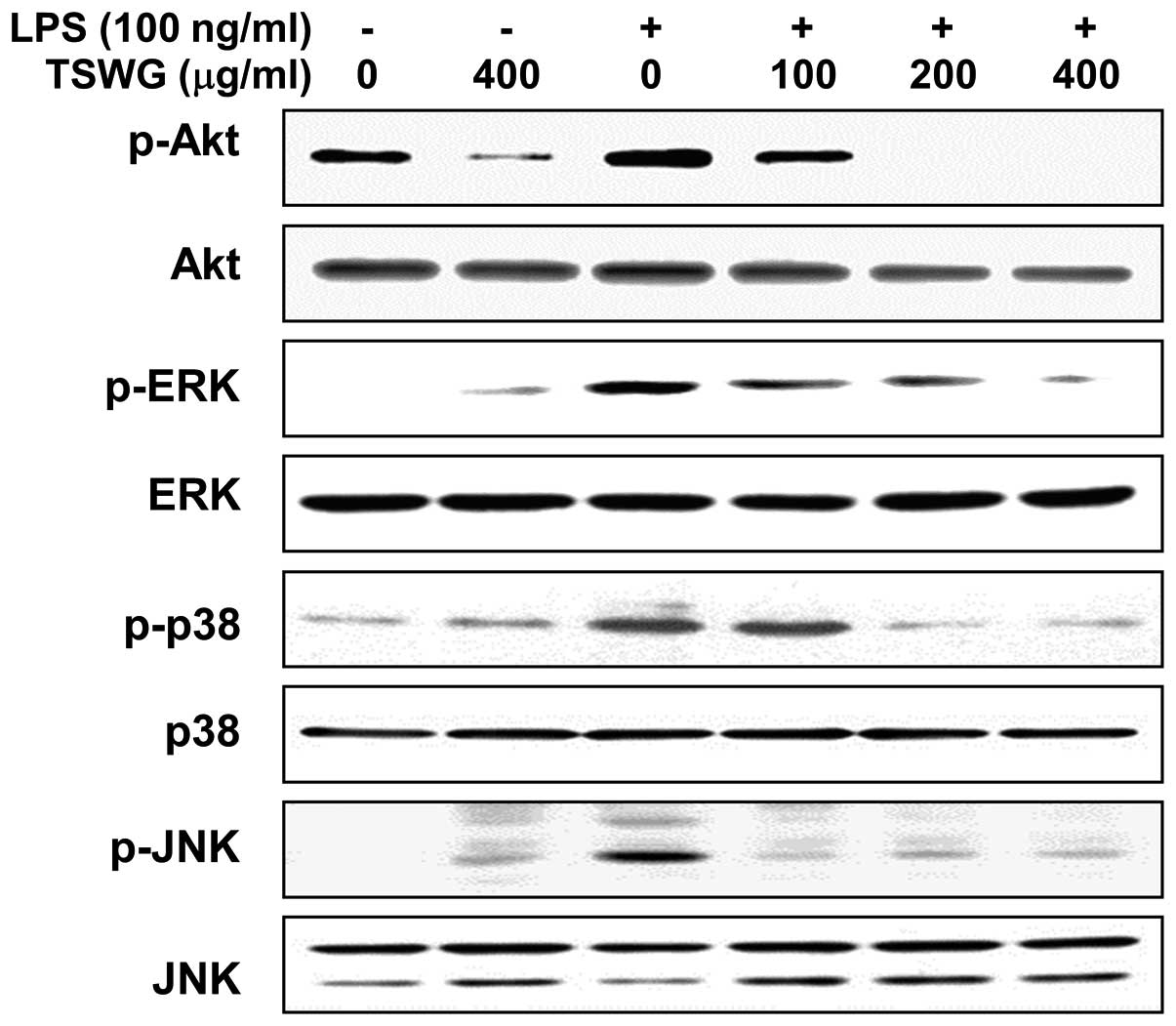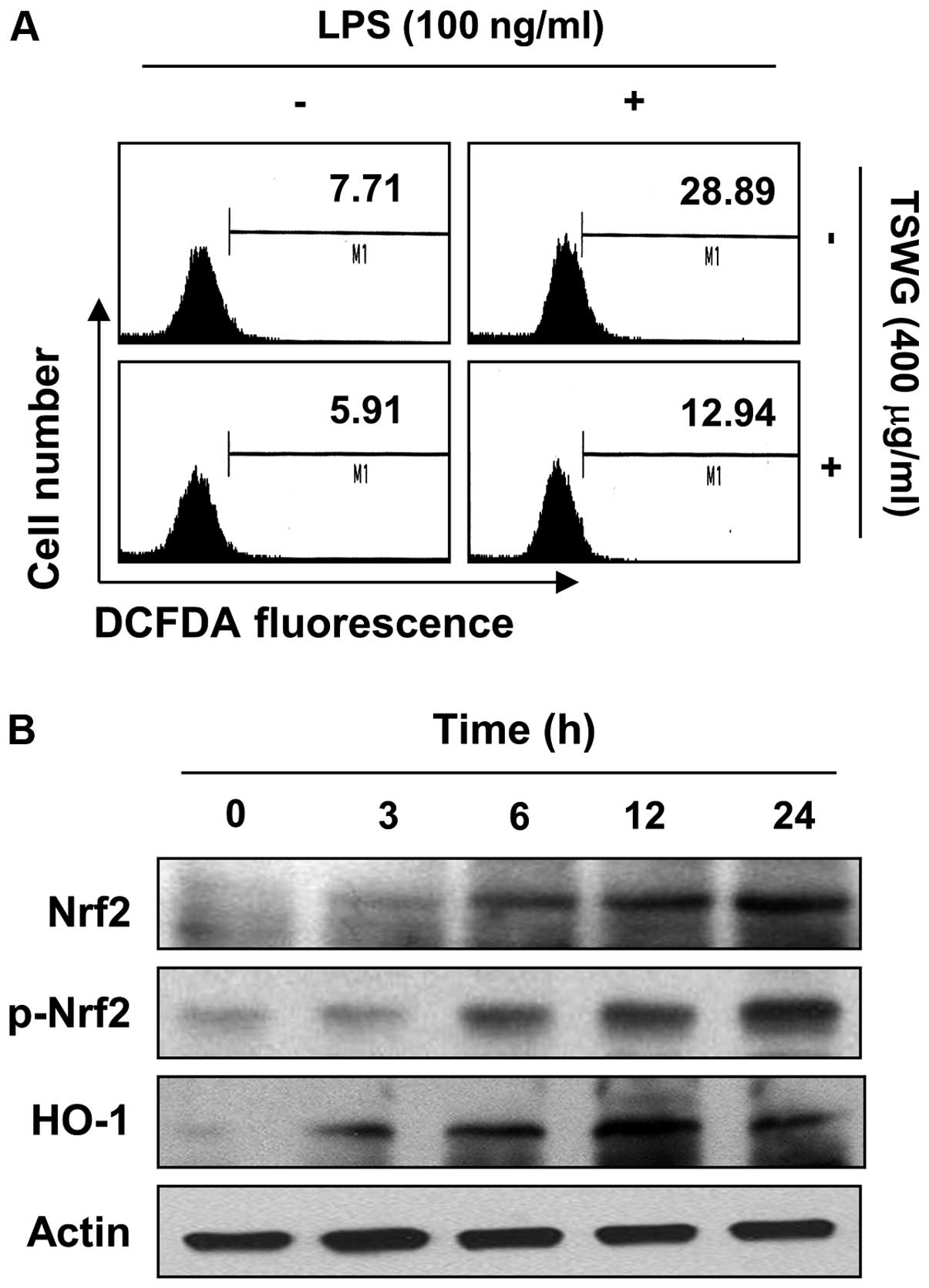|
1
|
Zhang X and Mosser DM: Macrophage
activation by endogenous danger signals. J Pathol. 214:161–178.
2008. View Article : Google Scholar
|
|
2
|
Cinel I and Opal SM: Molecular biology of
inflammation and sepsis: a primer. Crit Care Med. 37:291–304. 2009.
View Article : Google Scholar
|
|
3
|
Guha M and Mackman N: LPS induction of
gene expression in human monocytes. Cell Signal. 13:85–94. 2001.
View Article : Google Scholar : PubMed/NCBI
|
|
4
|
Korbecki J, Baranowska-Bosiacka I,
Gutowska I and Chlubek D: The effect of reactive oxygen species on
the synthesis of pros-tanoids from arachidonic acid. J Physiol
Pharmacol. 64:409–421. 2013.PubMed/NCBI
|
|
5
|
Ito K: Impact of post-translational
modifications of proteins on the inflammatory process. Biochem Soc
Trans. 35:281–283. 2007. View Article : Google Scholar : PubMed/NCBI
|
|
6
|
Ivanenkov YA, Balakin KV and Tkachenko SE:
New approaches to the treatment of inflammatory disease: focus on
small-molecule inhibitors of signal transduction pathways. Drugs R
D. 9:397–434. 2008. View Article : Google Scholar
|
|
7
|
Geronikaki AA and Gavalas AM: Antioxidants
and inflammatory disease: synthetic and natural antioxidants with
anti-inflammatory activity. Comb Chem High Throughput Screen.
9:425–442. 2006. View Article : Google Scholar : PubMed/NCBI
|
|
8
|
Kaspar JW, Niture SK and Jaiswal AK:
Nrf2:INrf2 (Keap1) signaling in oxidative stress. Free Radic Biol
Med. 47:1304–1309. 2009. View Article : Google Scholar : PubMed/NCBI
|
|
9
|
Lee HS, Lee GS, Kim SH, Kim HK, Suk DH and
Lee DS: Anti-oxidizing effect of the dichloromethane and hexane
fractions from Orostachys japonicus in LPS-stimulated RAW 264.7
cells via upregulation of Nrf2 expression and activation of MAPK
signaling pathway. BMB Rep. 47:98–103. 2014. View Article : Google Scholar :
|
|
10
|
Zhao CR, Gao ZH and Qu XJ: Nrf2-ARE
signaling pathway and natural products for cancer chemoprevention.
Cancer Epidemiol. 34:523–533. 2010. View Article : Google Scholar : PubMed/NCBI
|
|
11
|
Paine A, Eiz-Vesper B, Blasczyk R and
Immenschuh S: Signaling to heme oxygenase-1 and its
anti-inflammatory therapeutic potential. Biochem Pharmacol.
80:1895–1903. 2010. View Article : Google Scholar : PubMed/NCBI
|
|
12
|
Su ZY, Shu L, Khor TO, Lee JH, Fuentes F
and Kong AN: A perspective on dietary phytochemicals and cancer
chemoprevention: oxidative stress, nrf2, and epigenomics. Top Curr
Chem. 329:133–162. 2013. View Article : Google Scholar
|
|
13
|
Zhang D, Yasuda T, Yu Y, Zheng P, Kawabata
T, Ma Y and Okada S: Ginseng extract scavenges hydroxyl radical and
protects unsaturated fatty acids from decomposition caused by
iron-mediated lipid peroxidation. Free Radic Biol Med. 20:145–150.
1996. View Article : Google Scholar : PubMed/NCBI
|
|
14
|
Yun TK: Experimental and epidemiological
evidence on non-organ specific cancer preventive effect of Korean
ginseng and identification of active compounds. Mutat Res.
523–524:63–74. 2003. View Article : Google Scholar
|
|
15
|
Yun TK: Experimental and epidemiological
evidence of the cancer-preventive effects of Panax ginseng C.A.
Meyer. Nutr Rev. 54:S71–S81. 1996. View Article : Google Scholar : PubMed/NCBI
|
|
16
|
Dey L, Xie JT, Wang A, Wu J, Maleckar SA
and Yuan CS: Anti-hyperglycemic effects of ginseng: comparison
between root and berry. Phytomedicine. 10:600–605. 2003. View Article : Google Scholar : PubMed/NCBI
|
|
17
|
Attele AS, Zhou YP, Xie JT, Wu JA, Zhang
L, Dey L, Pugh W, Rue PA, Polonsky KS and Yuan CS: Antidiabetic
effects of Panax ginseng berry extract and the identification of an
effective component. Diabetes. 51:1851–1858. 2002. View Article : Google Scholar : PubMed/NCBI
|
|
18
|
Liu ZQ, Luo XY, Liu GZ, Chen YP, Wang ZC
and Sun YX: In vitro study of the relationship between the
structure of ginsenoside and its antioxidative or prooxidative
activity in free radical induced hemolysis of human erythrocytes. J
Agric Food Chem. 51:2555–2558. 2003. View Article : Google Scholar : PubMed/NCBI
|
|
19
|
Xie JT, McHendale S and Yuan CS: Ginseng
and diabetes. Am J Chin Med. 33:397–404. 2005. View Article : Google Scholar : PubMed/NCBI
|
|
20
|
Nag SA, Qin JJ, Wang W, Wang MH, Wang H
and Zhang R: Ginsenosides as anticancer agents: In vitro and in
vivo activities, structure-activity relationships, and molecular
mechanisms of action. Front Pharmacol. 3:252012. View Article : Google Scholar : PubMed/NCBI
|
|
21
|
Kim JH: Cardiovascular diseases and Panax
ginseng: A review on molecular mechanisms and medical applications.
J Ginseng Res. 36:16–26. 2012. View Article : Google Scholar : PubMed/NCBI
|
|
22
|
Shibata S: Chemistry and cancer preventing
activities of ginseng saponins and some related triterpenoid
compounds. J Korean Med Sci. 16(Suppl): S28–S37. 2001. View Article : Google Scholar : PubMed/NCBI
|
|
23
|
Lee B, Park J, Kwon S, Park MW, Oh SM,
Yeom MJ, Shim I, Lee HJ and Hahm DH: Effect of wild ginseng on
scopolamine-induced acetylcholine depletion in the rat hippocampus.
J Pharm Pharmacol. 62:263–271. 2010. View Article : Google Scholar : PubMed/NCBI
|
|
24
|
Mizuno M, Yamada J, Terai H, Kozukue N,
Lee YS and Tsuchida H: Differences in immunomodulating effects
between wild and cultured Panax ginseng. Biochem Biophys Res
Commun. 200:1672–1678. 1994. View Article : Google Scholar : PubMed/NCBI
|
|
25
|
Park BG, Jung HJ, Cho YW, Lim HW and Lim
CJ: Potentiation of antioxidative and anti-inflammatory properties
of cultured wild ginseng root extract through probiotic
fermentation. J Pharm Pharmacol. 65:457–464. 2013. View Article : Google Scholar : PubMed/NCBI
|
|
26
|
Lee B, Kim H, Shim I, Lee H and Hahm DH:
Wild ginseng attenuates anxiety- and depression-like behaviors
during morphine withdrawal. J Microbiol Biotechnol. 21:1088–1096.
2011. View Article : Google Scholar : PubMed/NCBI
|
|
27
|
Park JS, Hwang SY, Lee WS, Yu KW, Paek KY,
Hwang BY and Han K: The therapeutic effect of tissue cultured root
of wild Panax ginseng C.A. Mayer on spermatogenetic disorder. Arch
Pharm Res. 29:800–807. 2006. View Article : Google Scholar : PubMed/NCBI
|
|
28
|
Li H, Lee JH and Ha JM: Effective
purification of ginsenosides from cultured wild ginseng roots,red
ginseng, and white ginseng with macroporous resins. J Microbiol
Biotechnol. 18:1789–1791. 2008.PubMed/NCBI
|
|
29
|
Song JJ, Lim HW, Kim K, Kim KM, Cho S and
Chae SW: Effect of caffeic acid phenethyl ester (CAPE) on
H2O2 induced oxidative and inflammatory
responses in human middle ear epithelial cells. Int J Pediatr
Otorhinolaryngol. 76:675–679. 2012. View Article : Google Scholar : PubMed/NCBI
|
|
30
|
Lu YC, Yeh WC and Ohashi PS: LPS/TLR4
signal transduction pathway. Cytokine. 42:145–151. 2008. View Article : Google Scholar : PubMed/NCBI
|
|
31
|
Lin YC, Huang DY, Chu CL and Lin WW:
Anti-inflammatory actions of Syk inhibitors in macrophages involve
non-specific inhibition of toll-like receptors-mediated JNK
signaling pathway. Mol Immunol. 47:1569–1578. 2010. View Article : Google Scholar : PubMed/NCBI
|
|
32
|
Rietschel ET, Kirikae T, Schade FU, Ulmer
AJ, Holst O, Brade H, Schmidt G, Mamat U, Grimmecke HD, Kusumoto S
and Zähringer U: The chemical structure of bacterial endotoxin in
relation to bioactivity. Immunobiology. 187:169–190. 1993.
View Article : Google Scholar : PubMed/NCBI
|
|
33
|
Takeda K, Kaisho T and Akira S: Toll-like
receptors. Annu Rev Immunol. 21:335–376. 2003. View Article : Google Scholar : PubMed/NCBI
|
|
34
|
West TE, Ernst RK, Jansson-Hutson MJ and
Skerrett SJ: Activation of Toll-like receptors by Burkholderia
pseudomallei. BMC Immunol. 9:462008. View Article : Google Scholar : PubMed/NCBI
|
|
35
|
Janeway CA Jr and Medzhitov R:
Lipoproteins take their toll on the host. Curr Biol. 9:R879–R882.
1999. View Article : Google Scholar : PubMed/NCBI
|
|
36
|
Glushkova OV, Parfenyuk SB, Khrenov MO,
Novoselova TV, Lunin SM, Fesenko EE and Novoselova EG: Inhibitors
of TLR-4, NF-κB, and SAPK/JNK signaling reduce the toxic effect of
lipopolysaccharide on RAW 264.7 cells. J Immunotoxicol. 10:133–140.
2013. View Article : Google Scholar
|
|
37
|
Kobayashi Y: The regulatory role of nitric
oxide in proinflam-matory cytokine expression during the induction
and resolution of inflammation. J Leukoc Biol. 88:1157–1162. 2010.
View Article : Google Scholar : PubMed/NCBI
|
|
38
|
Haddad JJ and Land SC: A non-hypoxic,
ROS-sensitive pathway mediates TNF-alpha-dependent regulation of
HIF-1alpha. FEBS Lett. 505:269–274. 2001. View Article : Google Scholar : PubMed/NCBI
|
|
39
|
Ryan KA, Smith MF Jr, Sanders MK and Ernst
PB: Reactive oxygen and nitrogen species differentially regulate
Toll-like receptor 4-mediated activation of NF-kappa B and
interleukin-8 expression. Infect Immun. 72:2123–2130. 2004.
View Article : Google Scholar : PubMed/NCBI
|
|
40
|
Doyle SL and O’Neill LA: Toll-like
receptors: from the discovery of NFkappaB to new insights into
transcriptional regulations in innate immunity. Biochem Pharmacol.
72:1102–1113. 2006. View Article : Google Scholar : PubMed/NCBI
|
|
41
|
Kawai T and Akira S: Signaling to
NF-kappaB by Toll-like receptors. Trends Mol Med. 13:460–469. 2007.
View Article : Google Scholar : PubMed/NCBI
|
|
42
|
Kim BH, Oh I, Kim JH, Jeon JE, Jeon B,
Shin J and Kim TY: Anti-inflammatory activity of compounds isolated
from Astragalus sinicus L. in cytokine-induced keratinocytes and
skin. Exp Mol Med. 46:e872014. View Article : Google Scholar : PubMed/NCBI
|



